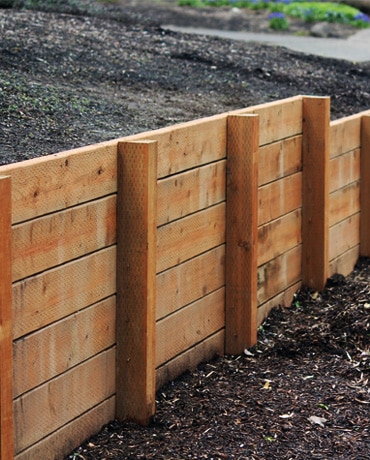Inexpensive and Premium Retaining Walls Sunshine Coast: What to Know
Inexpensive and Premium Retaining Walls Sunshine Coast: What to Know
Blog Article
Ensuring Structural Integrity: The Significance of Correctly Created Preserving Walls in Avoiding Incline Failing
In the world of civil engineering and construction, the significance of effectively built keeping wall surfaces in preventing slope failing can not be underrated. By exploring the intricate interaction in between these aspects, a much deeper comprehension of the critical duty that retaining wall surfaces play in maintaining architectural stability and protecting against slope failing emerges.
Duty of Retaining Walls in Stability
The necessity of retaining walls in ensuring slope security is critical in civil design practices. Maintaining walls serve an essential duty in stopping dirt erosion, taking care of water overflow, and preserving the architectural integrity of inclines. By sustaining upright or near-vertical quality changes, maintaining walls help to redistribute lateral stress applied by the dirt, thus minimizing the threat of incline failure.
One secret function of maintaining wall surfaces is to counteract the force of gravity acting upon the dirt mass behind them. This is achieved through appropriate layout and construction, which thinks about variables such as dirt type, wall height, drain provisions, and prospective additional charge loads. By properly keeping dirt within specified limits, these frameworks assist to maintain slopes and protect against landslides.
Moreover, maintaining walls add to the looks of landscapes while giving practical benefits. They can develop terraced degrees for landscaping, support highways or frameworks on hills, and enhance the overall usability of sloped terrain. In significance, preserving wall surfaces play an essential function in keeping incline security and guaranteeing the safety and longevity of civil engineering jobs.
Variables Influencing Wall Surface Performance
Aspects that influence the efficiency of keeping walls consist of dirt homes, wall surface design, and external tons. Appropriate wall style thinks about aspects like wall surface elevation, wall type (e.g., gravity walls, cantilever walls), reinforcement materials, drain systems, and construction techniques to ensure the wall can endure the lateral pressure exerted by the kept soil. By thinking about these aspects adequately, designers can create preserving walls that efficiently stop slope failure and make sure long-term architectural integrity.
Style Factors To Consider for Retaining Walls
Integrating the important facets of soil homes and external tons into the structural design procedure is crucial for creating reliable retaining walls that guarantee incline stability. When developing retaining wall surfaces, engineers must very carefully assess the qualities of the bordering soil, including its compaction, water drainage, and type residential or commercial properties. Understanding these dirt residential or commercial properties is critical for figuring out the ideal wall height, reinforcement, and thickness needed to withstand the side stress exerted by the dirt mass.
Moreover, outside lots such as surcharge lots from nearby structures or website traffic, in addition to seismic pressures, need to be considered throughout the layout phase. These loads can considerably influence the stability and efficiency of a maintaining wall, requiring the use of appropriate layout methods and products to reduce link possible failing threats.
Furthermore, the selection of suitable products, such as concrete, stone, or timber, must line up with the visual needs and site-specific problems. Factor of safety factors to consider, drain stipulations, and construction techniques are likewise crucial facets that affect the total layout and capability of keeping wall surfaces in protecting against slope failure. By thoroughly taking into consideration these layout considerations, engineers can guarantee the structural integrity and long-lasting security of retaining walls.

Construction Best Practices for Longevity
When creating maintaining walls for optimal durability and durability, adherence to industry-standard techniques and careful interest to detail are critical. To make certain the longevity of a maintaining wall, appropriate site preparation is crucial.
Including support strategies, such as geogrids or steel bars, can boost the architectural honesty of the preserving wall surface and protect against possible failings. By adhering to these building and construction best techniques, preserving wall surfaces can stand up to the examination of time and successfully prevent slope failure.
Relevance of Appropriate Maintenance
Normal upkeep is crucial for protecting the structural honesty and functionality of preserving walls over time. To ensure that maintaining walls continue to do their desired feature effectively, regular examinations should be performed to identify any indications of wear and tear.

Verdict
To conclude, keeping walls play a critical duty in ensuring structural honesty and protecting against basics incline failing. By taking into consideration factors influencing wall surface performance, sticking to make factors to consider, adhering to building and construction ideal methods, and applying correct upkeep, the durability of retaining walls can be made best use of. Retaining Walls Sunshine Coast. It is vital to recognize the importance of correctly constructed preserving wall surfaces in keeping security and preventing prospective risks linked with slope failure
Aspects that influence the efficiency of maintaining wall surfaces include soil homes, wall surface layout, and exterior tons. Correct wall surface design thinks about variables like wall surface height, wall kind (e.g., gravity wall surfaces, cantilever wall surfaces), support materials, drain systems, and construction techniques to ensure the wall can stand up to the lateral pressure applied by the maintained soil. By thinking about these aspects comprehensively, engineers can create maintaining walls that properly avoid incline look at these guys failure and make sure long-term structural honesty.
Maintenance jobs might include getting rid of drainage systems to protect against water buildup behind the wall surface, fixing any noticeable cracks or damages, and making sure that the wall surface is totally free from vegetation that might put in pressure on the structure. By thinking about variables influencing wall efficiency, adhering to develop factors to consider, adhering to building best practices, and applying appropriate upkeep, the sturdiness of maintaining wall surfaces can be maximized.
Report this page